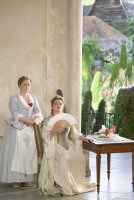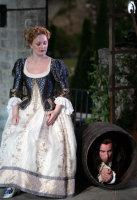Garsington is always a delight to visit - the size of the auditorium ensures it can't ever get too crowded - and this year saw a superb set of performances, including probably the finest Figaro I'm likely to see.
Over the years Garsington has brought us an impressive series of Richard Strauss revivals and this year saw David Fielding's new production of Arabella which I caught on 6 July. Set in a 1920s hotel, the semi-circular scenery worked rather better convexly in the third act than it did concavely for the first two. Where the central stairs and smooth creamy-white lines of the conclusion seemed to reflect the score admirably, the rather tenuous white lines against near total black surroundings was somewhat oppressive. Thankfully this was not true of either action or singing. Orla Boylan makes an intelligent and knowing Arabella - there is no sense of naivety in her performance and Mandryka has no chance once she has decided she wants him - and she floats the part magnificently. Peter Coleman-Wright was a bluff Mandryka, hiding his emotional warmth until the final moments when it flowered with great subtlety. A very large cast was drawn from strength and deftly handled from the pit by Elgar Howarth.
Two nights later, the last night of the season, brought Le Comte Ory. There are some English nights made for open air opera and this was one of them. Balmy and relaxed - the weather that is not the opera; but then given this production of Ory perhaps it applies to both! - the gardens were at their finest and many of us really did not want to leave at the end. There were small groups of people clustered round candles, finishing champagne or strolling in the deepening twilight by the lake. It was idyllic.
As to the Rossini; it is a strange work, perfect for a Festival and a gift to a chorus who go into drag at the drop of the hat. (We are already trying to work out which of next year's productions will allow the men to get their frocks on!) As Ory himself Colin Lee was in his element, balancing the very high coloratura of the part with some fairly earthy comedy. It worked a treat and was welcome on both levels. Victoria Simmonds was a real find as Isolier, a convincing young man as well as a fine Rossinian voice. She can be heard again this summer at the Proms and with ENO next season. Anne-Marie Owens knows how to cut a man dead with the barest of glances, and she did, while smouldering sensuously as the younger girls flaunted themselves at Ory. Juanita Lascarro was a complex mix as the Countess - trying to maintain order amongst the rabble of left over wives while obviously wanting to give in to temptation along with them. Rupert Goold set the work in 1950s France with Laura Hopkins designs bringing us a town square for the first scene and a heavily claustrophobic dormitory for the second. The chorus, as hinted above, loved every minute of it and we even had men in drag in the opening scene as 'village maidens' as well as the whole lot camping it up as nuns. That they are able to maintain such high musical standards while obviously thoroughly enjoying themselves is a tribute to David Parry's deft handling of the whole evening.
Good as both of these productions were, they paled somewhat beside the integrity and sheer professionalism of John Cox' Le Nozze di Figaro. A superficial reading of the production could easily be misleading. No obvious 'concept', no imposed ideas, not even any riotously funny pieces of business - and yet… and yet - everything is perfectly in place. Each character is filled out to create a totally credible human being with mood changes as swift as lightning. A tiny example; Barbarina, bewitchingly sung by Fflur Wyn, is overtly a teenager with all the arrogance and naivety that that implies. There is a lovely moment in the third act where she challenges the Count to give her Cherubino - a dangerous moment but one she just gets away with, and one for which she is immediately praised by Antonio. The Gardner himself is far more important to Figaro at Garsington than he might be elsewhere as we are very well aware of his fine gardening! Cherubino's leap is entirely naturalistic, down into the flower-beds and away out of sight. Doreen Curran's Cherubino matures as the evening progresses. From gaucheness over the Countess' ribbon she betrays an alarmingly Count-like arrogance when dealing with Barbarina in the last act - an ominous and quite revealing reading of the part. The Count himself is a nasty piece of work and his assumed humility seems very shallow. Julian Tovey was so convincing I was surprised he was not hissed at the end! Sarah-Jane Davies' long suffering Countess allows herself to side with the servants to try to turn the tables on Almaviva but we sense it will not last.


Le nozze di Figaro: Lucy Crowe as Susanna and Sarah-Jane Davies as the Countess (left), and Susanna with D'Arcy Bleiker as Figaro (right).
Click on either picture for a bigger version. Both photographs are © Johan Persson
D'Arcy Bleiker and Lucy Crowe are an ideal Figaro and Susanna. Like Shakespeare's Beatrice and Benedict we sense their sparring matches go back some way and that the nervousness before their eventual marriage is just the last of a long line of tiffs which always end happily. The French revolution may be a distant reality but the security of the Figaro/Susanna relationship is far more dangerous to the Almavivas than the revolt of the working class. Symptomatic of this is Bartolo's decision to marry Marcelina - middle class respectability rather than aristocratic decadence. The pair very finely sung by Lynton Black and Jennifer Rhys-Davies, with a sense of tangible delight in the discovery of their long-lost son.
Robert Perdziola's designs allowed us to see outside of each room as well as within it, giving us an insight into the comings and goings of the household, as well as the garden. It also showed us the inside of the Countess' closet - with Cherubino on tenter-hooks and Susanna planning her moment - a brilliant and highly effective idea. The last act set rightly drew a round of applause as it deftly transformed the stage into an extension of the gardens, It was the most convincing act four I have ever seen as hidden characters were hidden from each other yet visible to us - and that takes real skill.
Musically this was an ensemble piece with no starry voices, yet Mozart did not suffer for a moment. Jane Glover's firm handling of the score was precise and moving with the orchestra on fine form. John Cox has yet again shown that dedication to the demands of the score - finding the heart of the piece - brings its own rewards and grand ideas are not always necessary. If only all opera was as convincing as this! Next year we are to get Rimsky Korsakov's May Night, Donizetti's Don Pasquale and Mozart's The Philosopher's Stone.
Brian Hick
